|
|
Biography of Egon Schiele
|
|
|
1890 bis 1909
1910 bis 1911
1912 bis 1913
1914 bis 1918
|
|
1890-1909
|
|
 |
|
1890–1905
Egon Schiele is born on 12th June 1890 in Tulln the only son of Adolf (1850–1904) and Marie Schiele (1862–1935), née Soukup. His mother hails from the southern Bohemian town of Krumau (present-day Český Krumlov), his father from a northern German family. As station master of Tulln railway station, he lives with his family in a company apartment on the first floor of the station building.
Following two elder sisters, Elvira (1883–1893) and Melanie (1886–1974), Gertrude (†1981) is born in 1894. She models for Egon from an early age.
Between 1896 and 1900 Egon Schiele attends primary school in Tulln. He already draws eagerly, mostly trains and the station. In 1901 he is sent to high school in Krems, but due to ill success as a student, he is transferred to a secondary school in Klosterneuburg in 1902. Schiele’s performance remains poor, as he is more interested in his sketchbooks.
From 1902 the health of Schiele’s father deteriorates. In the autumn of 1904 he is no longer able to work, and the family moves to Klosterneuburg. Adolf Schiele dies on New Year’s Eve of that year aged 54 from syphilis-induced progressive paralysis. His death is a great loss to his son.
Schiele’s conservative uncle Leopold Czihaczek assumes guardianship of Egon. From this time onwards, he and his sister Gerti often use the free ticket of the State Railways that the two semi-orphans are entitled to. They visit Trieste several times, where their parents had spent their honeymoon.
Josef Müller
Adolf and Marie Schiele with Egon, Melanie and Elvira, 1893
Leopold, Private Collection
|
|
|
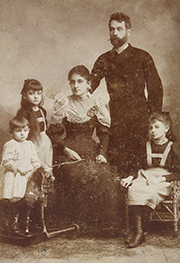
|
|
1906–1908
Seeing as Egon Schiele’s performance at school remains poor, alternative education options are discussed, with some of his teachers advocating artistic training. In the autumn of 1906 Egon Schiele applies successfully to the Vienna Academy of Fine Arts, the most exclusive art school in the Monarchy. Schiele subsequently moves to Vienna with his mother and sisters. He quickly finds like-minded people among his fellow students.
In 1907 Schiele first makes contact with Gustav Klimt, the celebrated master of Viennese Jugendstil. Schiele derives vital artistic impulses from Klimt, who also introduces him to important collectors. From 1907 the colors and shapes propagated by Jugendstil enter into his oeuvre and his paintings are rendered increasingly in a square format: the influence of Klimt is unmistakable.
In May 1908 Egon Schiele participates for the first time in an exhibition in Klosterneuburg. Heinrich Benesch, the superintendent of the Austrian Southern Railway, becomes aware of the young artist. Though not a wealthy man, Benesch is to become one of the most important collectors of Schiele’s works on paper – forming today’s Schiele collection at the Vienna Albertina.
In 1908/09 Schiele advances to the general painting class of Christian Griepenkerl, one of the main exponents of Vienna Ringstrasse painting. His relationship with the conservative professor is difficult from the beginning, and Schiele only earns barely passing grades in almost all subjects.
Anonymous
Egon Schiele with Palette, September 1906
Leopold, Private Collection
|
1909
At the invitation of Gustav Klimt, Schiele is given the opportunity in the summer of 1909 to exhibit at the International Kunstschau in Vienna. There, he makes contact with the architect and designer Josef Hoffmann and the Wiener Werkstätte.
Following severe disputes with Griepenkerl, several students found the Neukunstgruppe – Schiele serves as the association’s president and secretary. Their first group exhibition is held in late 1909 at the art salon Pisko on Schwarzenbergplatz. Anton Faistauer designs the exhibition poster, while Egon Schiele writes the manifesto: “There are only few, very few new artists. Chosen ones. The new artist must absolutely be himself; he must be a creator; he needs to have the basis on which he builds inside him, immediately and by himself, without using all that has been handed down from the past.”
Anton Faistauer
Exhibition Poster for Neukunstgruppe at Salon Pisko, 1909
Leopold, Private Collection
|
|
|
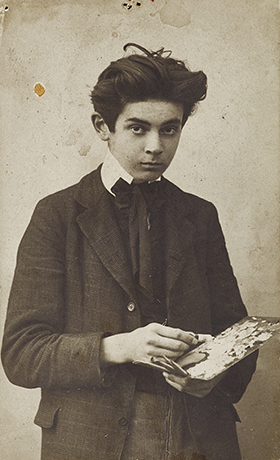
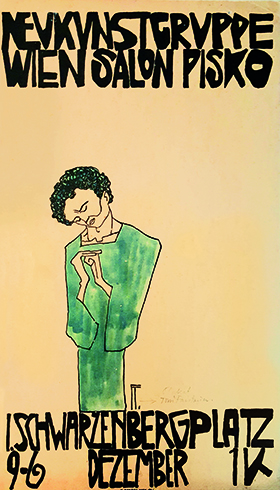
|
|
1910-1911
|
|
 |
|
1910
The year 1910 marks Schiele’s breakthrough in arriving at his own unique Expressionism. Breaking with the Academy also means breaking with the esthetic-decorative conventions of Jugendstil. In a series of swiftly created watercolors and paintings, he embarks on a path towards the most radical Expressionism. In a letter to the art historian Josef Strzygowski dated November 1910 Schiele writes: “I went through Klimt until March. Today I believe I am quite different.”
Almost abruptly the design patterns of Jugendstil based on ornaments and planar elements move into the background. Schiele now makes the body and bodily gestures the subject of his works. Beguiling beauty and tragic ugliness, sharp-edged lines and a denaturized coloring combine in the tense yet fragile figures to form a psychological quest for truth behind the veneer.
At the same time, Schiele starts to write poems influenced by Arthur Rimbaud, with poetic titles now also accompanying his paintings. The pantomimic talent and eccentric character of Erwin Dominik Osen, who for a short time is Schiele’s close friend, make a lasting impression on the artist. The dancer Moa Mandu also often models for Schiele. His encounter with the artist Max “Mopp” Oppenheimer results in a lasting friendship, which sees the two artists working together for months at a time and posing for one another.
At Vienna’s University Gynecological Hospital Schiele portrays pregnant women and infants with permission from the gynecologist Dr. Erwin von Graff – another formulation of the existential themes of sexuality, fertility, birth, frailty and death that have captured the artist’s imagination.
Schiele’s contributions to various exhibitions are well received. In February 1910 the second exhibition of the Neukunstgruppe is held at the Club of German Women Artists in Prague. Along with Schiele, the presentation also features works by Hans Böhler, Anton Faistauer, Albert Paris Gütersloh and Rudolf Kalvach, among others. The group makes extensive plans within the point of intersection between literature and painting.
At the invitation of Josef Hoffmann, the head of the Wiener Werkstätte, Schiele participates in the First International Hunting Exhibition held at the rotunda of the Vienna Prater, which is on display from May to October 1910. Schiele shows a now lost life-sized seated female nude. It is said that when Emperor Franz Joseph saw the work, he turned away from it uttering the words: “But this is awful.”
1911
The artist Paris von Gütersloh writes an impressive essay on Schiele. The art critic Arthur Roessler becomes Schiele’s promoter and publishes texts about him. A first collective exhibition is held at the Galerie Miethke, and Schiele establishes contact with the Munich art dealer Hans Goltz. In November Schiele is admitted into the artists’ association Sema whose other members include, among others, Paul Klee and Alfred Kubin.
In the spring he meets and falls in love with his model Walburga “Wally” Neuzil. The couple moves to Krumau (today Český Krumlov), his mother’s birthplace. There, Schiele embarks on one of his artistically most fruitful periods. However, his concubinage with Wally Neuzil and the fact that he creates nude drawings out of doors cause offence, forcing them to leave Krumau in the early summer.
Soon afterwards, Schiele settles in Neulengbach, a small rural community close to Vienna. He enjoys the countryside and intends to stay there indefinitely.
Catalogue for the exhibition “Egon Schiele” with a preface by Albert Paris von Gütersloh, Galerie Miethke, Vienna 1911
Leopold, Private Collection
|
|
|
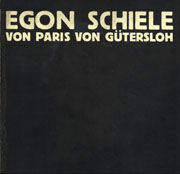
|
|
|
|
|
|
1912-1913
|
|
 |
1912
This period of early creative success comes to an abrupt end: In April, Egon Schiele is accused of having abducted a girl and molested adolescents. He is remanded in custody in Neulengbach for three weeks.
The charge of molestation is eventually dropped, but because children visiting his house would have been exposed to nude drawings hanging up on his walls, he is sentenced to three days in prison. A profound personal crisis ensues.
Following his release from prison in May 1912, Schiele returns to Vienna.
In the summer he embarks on several trips, visiting his favorite places of the past, including Trieste, where he executes studies of boats in the harbor. In August he travels to Munich, where he sees works by the German Expressionists. Wally Neuzil accompanies the artist to the Wörthersee in Carinthia and to Lake Constance in Vorarlberg.
At the international exhibition of the artists’ association Sonderbund held in Cologne from May to September – one of the most eminent presentations of the pre-war era featuring more than 600 exhibits and affording an overview of contemporary art – includes three paintings by Schiele.
In the summer, Schiele enters into an animated exchange with the German patron of the arts Karl Ernst Osthaus, a museum founder and head of the artists’ association Sonderbund. Osthaus organizes an exhibition at the Folkwang Museum in Hagen showing works by Wilhelm Lehmbruck side by side with works by Egon Schiele. During this exhibition, Osthaus buys the painting “Dead City” (VI) for the museum’s collection. It is the first acquisition of a Schiele work by a museum.
In October Schiele finds an appropriate studio situated at Hietzinger Hauptstraße 101 in Vienna’s 13th district, which he will use for the rest of his life. Schiele has the walls painted white, while all his furniture is kept in varying nuances of black.
While Wally Neuzil is his most important model at the time, she is never his only one. She does not pose for free, but receives payment for the sittings like all of his other professional models. She supports the artist in his everyday business affairs. Schiele makes no secret of his relationship with Wally Neuzil with either his patrons and collectors or his family.
Gustav Klimt introduces Schiele to the eminent art collector and industrialist August Lederer. The married couple August and Serena Lederer are among the most important collectors of Klimt’s works, and their son Erich becomes Schiele’s student and friend. Schiele spends Christmas and New Year at the family’s estate in the Hungarian town of Györ.
Egon Schiele
Self-Portrait with Raised Bare Shoulder, 1912
Leopold Museum, Vienna
|
1913
Egon Schiele increasingly makes a name for himself as an artist. On 17th January he is admitted to the Association of Austrian Artists presided over by Gustav Klimt. He participates in exhibitions in Budapest, Munich, Düsseldorf, Dresden and Berlin as a result. From June to July the Munich gallery Goltz holds a major solo exhibition. In Vienna Schiele participates in the International Black and White Exhibition well as in the 43rd Exhibition of the Vienna Secession. He also starts to contribute to the Berlin magazine Die Aktion which publishes some of his drawings and prose poems.
Schiele travels once more to Trieste, visits Salzburg and Munich, and relaxes for more than a month at Lake Ossiach in Carinthia. Together with Wally, he takes a trip to Maria Laach on Jauerling Mountain in the spring and makes an artistic entry into the guest book there. During the summer months, the couple spend a week in Krumau. In July they are invited by Arthur Roessler and his wife Ida to spend a few days at their house in Altmünster on the Traunsee.
|
|
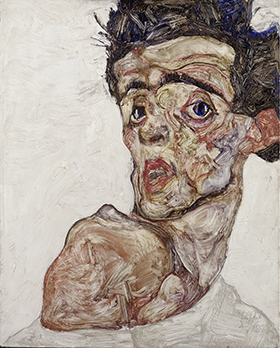
|
|
1914-1918
|
|
 |
1914
The house opposite Schiele’s studio on Hietzinger Hauptstrasse is home to the Harms family. In early 1914 Schiele starts a dalliance with the two daughters Edith and Adele.
Schiele receives an offer from Hans Goltz in Munich for a funded stay in Paris, but never makes the trip. He also considers moving to Berlin or Munich.
When the heir to the throne Archduke Franz Ferdinand is murdered in Sarajevo on 28th June 1914 Austria-Hungary declares war on Serbia. The general mobilization of troops begins three days later. Schiele does not share many of his fellow artists’ patriotic enthusiasm for the War.
Schiele starts to experiment with new techniques. In the spring the painter and graphic artist Robert Philippi introduces him to the techniques of woodcuts and etchings. Collaborating with the photographers Anton Josef Trčka and Johannes Fischer, Schiele experiments with photographic self-portraits.
Schiele increasingly participates in exhibitions despite the outbreak of World War I. That year, he first participates in exhibitions outside of the Austro-Hungarian Empire – in Rome, Brussels and Paris.
Anton Josef Trčka
Egon Schiele with toy horse, in the background the painting “Houses by the Sea (Row of Houses)”, 1914
Leopold, Private Collection
|
1915–1917
In the spring of 1915 Schiele separates from Wally Neuzil, as Edith Harms demands “proper circumstances”.
In late May 1915 Schiele has to undergo another army physical and is deemed fit to enlist. A few days before, he marries Edith Harms. Following a brief honeymoon, he is barracked together with thousands of other young men.
Following his basic military training, he is sent to Vienna, where he digs trenches and guards Russian war prisoners. He has little time left for artistic work. In December 1915 he is able to exhibit at the Berlin Secession. His work Levitation is hung opposite Gustav Klimt’s Death and Life.
In May 1916 Schiele is transferred to Lower Austria to a camp for Russian officers. He portrays these officers, but rather than as part of an anonymous crowd, he depicts them in a highly personal way, capturing the essence of their beings.
In January 1917 he is detailed to Vienna; his superiors support his artistic work. Schiele starts to make plans for the time after the War: “We know that the time of impending political peace will bring about a great clash between our civilization’s materialistic tendencies and those remnants of noble culture that this mercantile age has still left us.”
Egon Schiele
Round Table. Poster for the 49th Vienna Secession Exhibition, 1918
Leopold Museum, Vienna
|
1918
The 49th Secession Exhibition held in 1918, which features 19 of his oil paintings and almost 30 drawings, marks Schiele’s breakthrough. He sells five paintings and several drawings. The Österreichische Galerie Belvedere purchases the portrait of his wife Edith – the first acquisition of a Schiele painting by an Austrian museum.
His exhibition poster announcing the 49th Secession Exhibition, The Round Table, is a declaration of his artist friendship. Schiele presides over the table, while the place opposite him is reserved for Gustav Klimt. Klimt had died on 6th February following a stroke: “An unbelievably accomplished artist – a man of rare depth – his work a sanctuary.”
In October his pregnant wife Edith contracts the Spanish Flu and dies on the 28th of that month. Schiele draws his wife on her deathbed – but he too falls ill. On 31st October, the day of his wife’s funeral, Egon Schiele dies. His last words would come true: “The War is over – and I must go. My paintings shall be shown in all the world’s museums.”
Martha Fein
Egon Schiele on his deathbed, 1918
Leopold, Private Collection
|
|
|
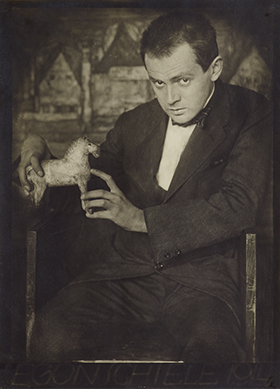
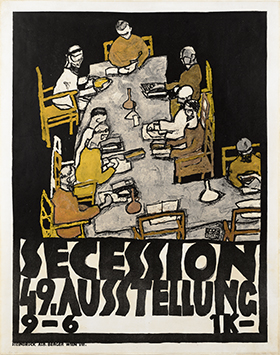
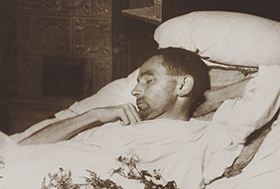
|
| |
|

|
| |
|
|
|
|